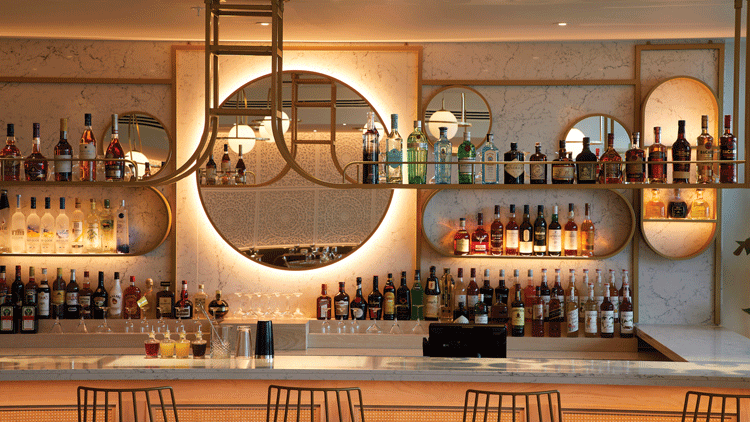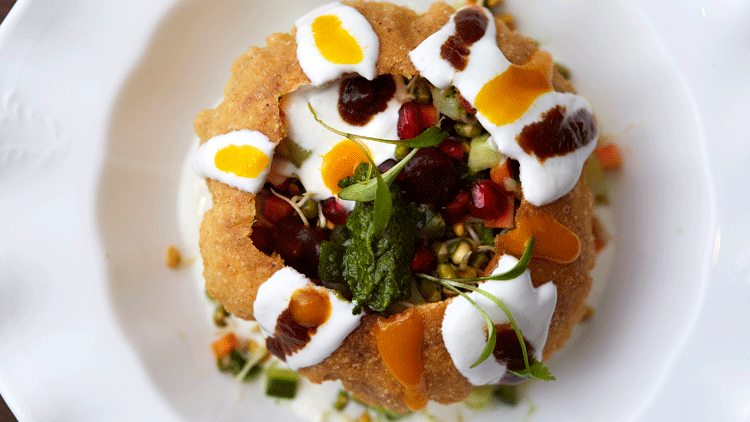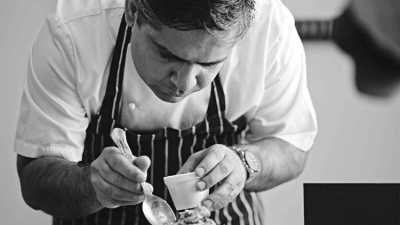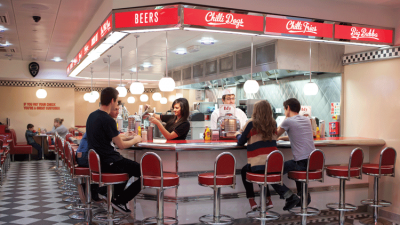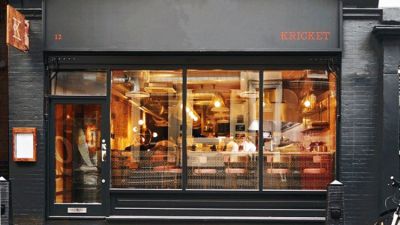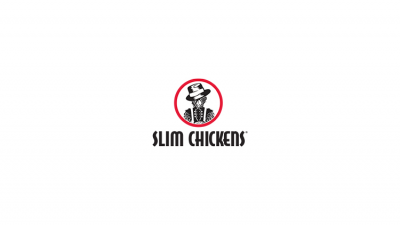Vivek Singh talks expansion, new wave Indians and the plight of the curry house
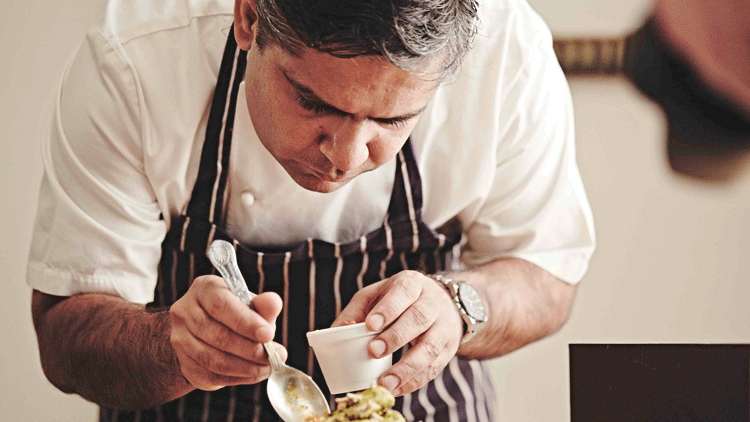
When the company behind Giraffe, Ed’s Easy Diner and Harry Ramsden’s bought Indian restaurant group Cinnamon Collection and announced its intention to rapidly scale its two key brands – Cinnamon Kitchen and Cinnamon Bazaar – commentators could have been forgiven for predicting the arrival of an Indian answer to Giraffe.
Boparan Holdings has earmarked significant growth for Cinnamon Collection, which it bought at the start of 2016 for an undisclosed sum, with the somewhat lofty target of opening almost 100 sites across its brands. And yet the group isn’t obviously scaleable.
Cinnamon Bazaar, for example, the Indian restaurant that opened in Covent Garden late last year, holds a Bib Gourmand, an award handed out by the Michelin Guide that recognises restaurants that offer high-quality food at a reasonable price point.
Cinnamon Kitchen, meanwhile, the more casual follow up to the group’s flagship high-end restaurant The Cinnamon Club that opened in the City in 2008, is a chef-led restaurant serving involved modern Indian cuisine. Can a business that serves food of such quality really hit treble figures without making huge compromises on quality? Its creator and custodian Vivek Singh believes it can.
“A big part of the appeal to Boparan was probably our focus on operating at a certain level in terms of price point and skill. What we do is quite different to anything else in the group,” he says. “I understand the benefits of economies of scale and streamlining. But if you get your food to the point that it is idiot-proof, you will only attract idiots to work for you. That’s not the arena in which I want to be operating.”
Not currying favour
Born in West Bengal, Singh is one of the UK’s most influential Indian chef restaurateurs and has an enviable media profile to boot. Along with a handful of peers, he is credited with revolutionising the perception of Indian food in Britain, and globally. Like other high-profile Indian chefs, he cut his teeth at the grand hotels of India cooking a mix of Indian and international cuisines.
Opened in 2001, his debut restaurant The Cinnamon Club was the first Indian in the country to not serve curry. It also eschewed the other trappings of the Anglo-Indian restaurant experience, including poppadoms and draught beer.
“We had to avoid these items or people would have defaulted to them,” he says. “I wanted to prove there was more to Indian food than curry.”
Located in the Grade II-listed former Westminster Library, The Cinnamon Club was not an instant critical success, but it certainly got people talking. “The initial reviews were middling at best,” the 46-year-old recalls. “But the awareness was phenomenal because people either loved it or hated it.”
Although aspects of its philosophy were similar, The Cinnamon Club was – and still is – a markedly different proposition to the Michelin-courting fine-dining restaurants opened by the likes of Vineet Bhatia, Atul Kochhar and Alfred Prasad in the early 2000s. “The Cinnamon Club is a much larger space, with the private rooms we have well over 200 covers. The restaurant would not have succeeded if we’d gone down the fine-dining route,” says Singh.
Though it is high-end, the restaurant’s operational model owes more to French brasseries and British grill rooms than fine-dining restaurants. Opened in 2008, Singh’s second restaurant Cinnamon Kitchen isn’t fine dining either, but the City of London venue now offers a tasting menu alongside à la carte and good-value set menus (for the area, at least).
Shifting down to casual dining
The group’s first stab at a casual restaurant proper – Cinnamon Soho – opened in 2012. The transition from relatively pricey restaurants to cheaper ones was not easy for Cinnamon Collection with the group unusually honest about Cinnamon Soho’s lacklustre performance in the early days of the restaurant.
“There was a lot of baggage from The Cinnamon Club and Cinnamon Kitchen,” says Singh. “Cinnamon Soho hasn’t been a huge financial success for us, but it now washes its face. From a talent and learning perspective it’s been one of the best things I’ve done. It’s been a nursery for talent and we’ve created some of our best-selling dishes, such as our ox cheek vindaloo and rogan josh shepherd’s pie.”
The Cinnamon Kitchen brand, meanwhile, made its regional debut last year at Oxford’s Westgate Centre and a third will open at Battersea Power Station this year. The space is comparable to the Oxford and City sites at 4,000sq ft.
“We’re still finding our feet but Oxford is going well,” says Singh. “The feedback from my senior team is that the market for Indian food in the regions is a lot like the market in London 17 years ago. It might be a bit too adventurous and perceived to be a bit pricey, but we’re confident people will come round.”
Cinnamon Kitchen Oxford is not a carbon copy of its older sister. It’s more all-day orientated and the cocktail offer is more prominent and involved. The price point is a little lower too, although the restaurant does serve premium ingredients including venison, rack of lamb and king prawns.
Shaking up the format: Cinnamon Kitchen Oxford has a bigger emphasis on cocktails
With regards to the third Cinnamon Kitchen, Singh admits that he is a sucker for iconic buildings, even if they are in awkward locations. “Old Westminster Library was off the beaten path in an area that was very low on restaurants. But we serve 100,000 people a year there now. Cinnamon Kitchen was the same. Devonshire Square is hidden away but I loved it because the building was a former spice warehouse. It’s always going to be a punt, but I believe Battersea Power Station is the South Bank of the future.”
While Cinnamon Kitchen is intended for larger cities, Cinnamon Bazaar is designed for sub 3,000sq ft sites in the provinces. Though it is yet to secure a second site, it is understood to be the real growth brand. Singh and commercial director Tina English – who joined the business shortly before the sale to Boparan – are currently looking at locations in the Surrey commuter belt and expect to open a restaurant this year. It’s a much slower rate of growth than initially intended; as it acquired the group Boparan said it hoped Cinnamon Bazaar would reach 10 sites by the end of the 2017.
Boparan is behind a number of major food companies including Bernard Matthews; Grove Farm Turkey; and 2 Sisters Food Group. Singh says that from a supplier perspective, the Cinnamon Group operates as it did prior to the sale and is not obliged to purchase products from its parent group, which has endured a food scandal around factory workers changing the slaughter dates on poultry.
Along with capital, the biggest benefit of being owned by Boparan is access to property. The sheer scale of the group gives it access to sites smaller groups would likely miss out on and its covenant strength (its ability to pay its rent on time) means landlords are keen to work with Boparan. There’s also the possibility of converting some underperforming Giraffe and Ed’s Easy Diners locations to Cinnamon Collection brands, although Singh says this has yet to be discussed.
The majority of the group’s chefs are Indian but Singh does not believe you need Indian chefs to cook great Indian food. “Because of our connections, we inevitably employ a lot of people that are Indian. But I’ve always had non-Indians in my kitchen,” says Singh, who took on Will Bowlby (the chef and co-founder of up and coming Indian restaurant outfit Kricket) a few years ago. “There are no secrets in my kitchen. There’s nothing I don’t want people to take away.”
A new wave of Indian restaurants
In the two years that have passed since Boparan acquired Cinnamon Collection, the Indian sector has changed a great deal with several new-wave Indian restaurants on their way to becoming national players such as Dishoom, Mowgli and Bundobust.
Does the amount of competition worry Singh? Not really. “The key thing about the Indian market is that all the brands are very different. All these restaurants have at least one unique selling point. I don’t think having a Dishoom in the same city as a Cinnamon Bazaar or Cinnamon Kitchen is going to cause a problem.”
He has a point. The new-wave Indian market is far more differentiated than, say, the Italian or the US food market, largely because Indian cuisine is as vast and varied as the country itself. But what is Cinnamon Bazaar’s USP?
“We don’t believe the other players are as food-led as ourselves,” he says. “They don’t have the same layering of different regions, flavours and techniques. We don’t stand still and we respond to the seasons. We won’t take a cookie cutter approach to the rollout either. Each new site will bring something different to
the table.”
A lot of Cinnamon Soho’s DNA has found its way into Cinnamon Bazaar. A number of the menu items are the same or at least similar and the price point is comparable. The overall feel of Cinnamon Bazaar is far removed from the high street curry houses, but elements of the concept have been designed to subtly reference the traditional Indian restaurant experience.
Raj Kachori (crisp pastry shell filled with sprouted mung, fenugreek, pickled kachumber and spiced yoghurt)
“It’s a more direct Indian aesthetic than at any of our other restaurants,” says Singh. “It’s also possible to treat it like a curry house. We serve three traditional curries and also items that I’d describe as deconstructed curries. But there are lighter dishes on the menu and dishes for those who want to be more adventurous.”
In common with its newer peers, Cinnamon Bazaar also addresses one of the high street curry houses biggest shortcomings – its status as an evenings-only establishment. Bright and airy, the restaurants are all-day affairs, serving everything from breakfast parathas on weekday mornings to an afternoon tea that involves the likes of tandoori chicken and chutney sandwiches; paneer naan pizza; and carrot halwa.
Singh hints the offer will evolve as the business grows but insists it will continue to cook fresh food. “That’s what we hold dear. Some dishes need to be freshly cooked. That’s what we charge a premium for, it’s part of the business model. But I would not rule out a production kitchen for some dishes. I don’t believe that it’s impossible to replicate the quality across a much larger group.”
Like its peers, the brand is well-placed to partly fill the gap in the market left by traditionally run curry houses. And Singh is not at all sentimental about the struggling high street curry scene that his brands may eventually replace.
“I’ve seen it coming for a decade,” he says. “There is a lack of imagination. People might say: ‘if it’s not broken, don’t fix it’. But if something does not evolve it’s going to die. That’s the way
the world works.”
He also believes that some Indian restaurants have limited value as an enterprise and are being propped up by family members’ willingness to work long hours for low pay and legally questionable accounting practices.
“There’s no value for anyone in a business like that. Not the Government, not the public and not even the people that work there. These businesses may be British institutions, but in many cases they’re not pulling their weight and won’t be missed."
"This new wave of Indian restaurants – and I’d include what we do in that category – are a cracking example of what enterprise can do. They provide training, pay people a decent wage and pay their taxes too. They create opportunities and are run in a way that benefits everyone.”
This is a web version of an article that first appeared in the January issue of Restaurant magazine, the leading title for the UK's restaurant industry. For more features, comment, interviews and in-depth analysis of the restaurant sector subscribe to Restaurant magazine here.
